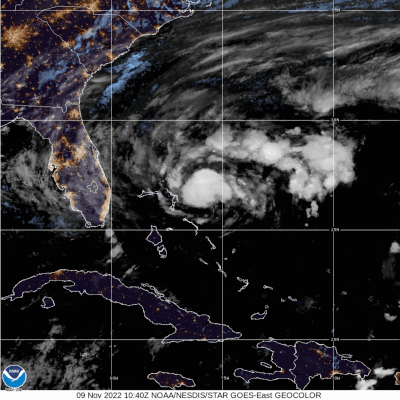
November weather in most of North America is synonymous with chilly breezes rustling through red, yellow and orange leaves as fall edges closer to winter. It’s generally not a time people associate with destructive tropical cyclones churning toward the U.S.—but that’s exactly what is happening as Tropical Storm Nicole bears down on Florida, where it is expected to make landfall as a hurricane.
Though such tropical systems are less common at this time of year, the official Atlantic hurricane season actually lasts through November 30. And storms can form even after that point, as notably happened during the blockbuster 2005 season when Tropical Storm Zeta shockingly formed on December 20 and lasted until January 6.
Hurricane season, which begins on June 1, brackets the time of year when atmospheric and ocean conditions are most suitable for storm formation. The season peaks sharply from the end of August through early October, when ocean warmth at end of summer coincides with wind conditions that are generally more favorable to storm formation. Storm activity “starts to decline pretty quickly once November 1 hits,” says Jill Trepanier, a hurricane researcher at Louisiana State University. That drop means November is also “the quietest month from the perspective of U.S. landfall activity,” says Ryan Truchelut, a meteorologist and co-founder of WeatherTiger, a private weather-forecasting group. Only 10 tropical storms and three hurricanes have struck the U.S. during November going back to 1851, he says, so on average such a landfall would happen about every 10 to 15 years.
There are some years that are true outliers. Three November storms, one of them a hurricane, formed in 2005. More recently, “November was crazy in 2020,” Truchelut says, thanks to exceptionally warm waters in the Caribbean. Hurricane Eta hit Nicaragua as a category 4 storm, followed two weeks later by another category 4 hurricane, Iota.
Any storms that do form in November tend to be weaker for the same reasons they are somewhat rare. As fall progresses, solar energy shifts from the Northern Hemisphere to the Southern Hemisphere and more northerly latitudes rapidly cool down, Trepanier explains. This creates a big contrast with the lingering warmth farther south, strengthening the polar jet stream—which then sends incursions of cold air southward. These incursions increase a feature called wind shear (when winds vary in speed and direction at different levels of the atmosphere), and that in turn disrupts the convection at the core of tropical systems that powers them.
Though Nicole will probably be relatively weak in terms of wind speed, its winds cover a large area and are thus expected to bring storm surge to the entire east coast of Florida. This happens to coincide with a period of higher-than-normal high tides, which will amplify surge amounts.
Historically, any November storms that do hit the U.S. have tended to strike Florida because they most commonly form in the nearby western Caribbean, Truchelut says. The most recent November hurricane to hit the state was Kate, which struck the Florida panhandle on November 22, 1985, as a category 2 storm. Nicole will set the record for the latest in the season that a storm has hit the state’s east coast. The previous record holder was the Yankee Hurricane, which made landfall near Miami Beach on November 4, 1935 (this was before meteorologists began giving official names to hurricanes and tropical storms).
Having a late-season threat from Nicole so relatively soon after Eta hit the state as a tropical storm in 2020—twice—raises the question of whether late-season storms will become more frequent as climate change brings warmer ocean waters, Truchelut says. A study he co-authored, published earlier this year in Nature Communications, looked for statistical evidence that the hurricane season might be growing longer at both ends. Though this research found strong evidence that the season is starting earlier, that evidence was weak for the end of the season. It is possible there is a trend that simply cannot yet be detected, he notes, because “it’s hard to get a trend for rare events.”
Nicole also underscores the lesson that people living in hurricane-prone areas need to keep paying attention and be prepared to act on forecasts, even after the peak of the season has passed, Trepanier says. “Driving home that point is important.”
